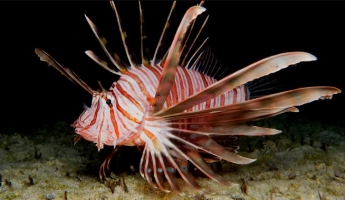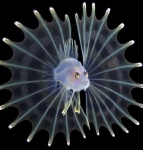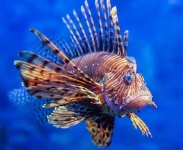Lionfish are visually stunning carnivorous fish that are slow-moving and conspicuous. They rely on their unusual coloration and fins to discourage would-be predators.
Lionfish were introduced to Florida in 1980, where records showed up to six individuals were freed following the destruction of an aquarium in Biscayne Bay as a result of Hurricane Andrew in 1992. Lionfish have undergone rapid expansion in the Atlantic and Caribbean. The LionFish originated from the Indo-Pacific region, including the South Pacific and Indian Oceans. The scientific names are Pterois volitans(red lionfish) and Pterois miles (devil firefish). Lionfish belong to the Scorpaenidae family, which includes other venomous fish such as Scorpionfish and Stonefish.
Lionfish are capable of eating anything big enough to fit in their mouth and go for long fasting periods if needed.
What They Look Like and How They Act

Lionfish have long, fan-like pectoral fins and bold zebra-like stripes that act as a warning to predators. They have venomous spines and can use their incredible speed and agility to ambush and capture prey.
Without natural enemies in their waterways, Lionfish can act as apex predators, throwing the natural balance of underwater food webs out of whack. You will see unique brown or maroon and white stripes or bands that adorn the head and body. They have meaty tentacles just above their eyes and just below their mouth.
Adult lionfish measure up to 18 inches, and juveniles can be 1 inch or smaller. Lionfish have cycloid scales ( a type of fish scale that is Smooth and oval or elliptical).
How Are They Disrupting the Marine Ecosystems
Lionfish introduction into non-native waters has harmed the marine ecosystem. The lack of natural predators and their voracious appetite allow them to dominate the reef environment, which leads to several problems. By consuming a large amount of prey and reproducing faster, Lionfish outcompete native predators such as moray eels and groupers.
Lionfish feed on juvenile fish, including those of economic and ecological importance, such as snappers and groupers. This disrupts the food chain and reduces the fish stock that local communities rely on for Food and income.
By preying on herbivorous animals, Lionfish reduce the number of fish that control algae growth. Excessive algae can smoothen coral reefs, leading to the loss of marine biodiversity and reef degradation.
Breeding and Life Stages

One of the factors contributing to the success of lionfish as an invasive species is their rapid reproductive capacity. A female lionfish can release thousands of eggs in a single reproductive event and reproduce year-round.
Moreover, lionfish larvae can drift long distances, guided by ocean currents, further facilitating their colonization of new areas. Due to high reproductive output and the ability to colonize new habitats quickly, the range of the lionfish population is expanding.
How Lionfish Defend Themselves with Venom

Lionfish have a passive puncture defense system. They possess up to 18 venomous spines that serve as a strong defence mechanism against predators. These spines contain a venom called the Neurotoxic venom.
This venom can cause severe pain and swelling, vomiting and nausea, tenderness, diaphoresis, hypertension and difficulty in breathing in dire cases. Lionfish stings are venomous, not poisonous.
How the Invasive Species Affects Local Economies and Communities
The invasion of Lionfish created economic and environmental challenges. The reduction of the native fish population affects local fishing industries and disrupts the ecosystem that attracts tourists.
Furthermore, the loss of herbivorous fish due to lionfish predation has caused unhealthy reefs that impact coastal protection and marine biodiversity. However, human beings have been procuring solutions to control the Lionfish population. Many groups host lionfish culling events to reduce their numbers and activities.
Some restaurants now promote lionfish as a sustainable seafood option, encouraging their harvest in order to reduce their numbers. Environmental organizations educate and inform communities about lionfish and encourage active participation in control efforts.

